Roee Diamant
Automatic Detection and Annotation of Sperm Whale Codas
Jul 24, 2024Abstract:A key technology in sperm whale (Physeter macrocephalus) monitoring is the identification of sperm whale communication signals, known as codas. In this paper we present the first automatic coda detector and annotator. The main innovation in our detector is graph-based clustering, which utilizes the expected similarity between the clicks that make up the coda. Results show detection and accurate annotation at low signal-to-noise ratios, separation between codas and echolocation clicks, and discrimination between codas from simultaneously emitting whales. Using this automatic annotator, insights into the characterization of sperm whale communication are presented. The results include new types of coda signals, analyzes of the distribution of coda types among different whales and for different years, and evidence for synchronization between communicating whales in terms of coda type and coda transmission time. These results indicate a high degree of complexity in the communication system of this cetacean species. To ensure traceability, we share the implementation code of our coda detector.
Multiple Mobile Target Detection and Tracking in Active Sonar Array Using a Track-Before-Detect Approach
Apr 16, 2024



Abstract:We present an algorithm for detecting and tracking underwater mobile objects using active acoustic transmission of broadband chirp signals whose reflections are received by a hydrophone array. The method overcomes the problem of high false alarm rate by applying a track-before-detect approach to the sequence of received reflections. A 2D time-space matrix is created for the reverberations received from each transmitted probe signal by performing delay and sum beamforming and pulse compression. The result is filtered by a 2D constant false alarm rate (CFAR) detector to identify reflection patterns corresponding to potential targets. Closely spaced signals for multiple probe transmissions are combined into blobs to avoid multiple detections of a single object. A track-before-detect method using a Nearly Constant Velocity (NCV) model is employed to track multiple objects. The position and velocity is estimated by the debiased converted measurement Kalman filter. Results are analyzed for simulated scenarios and for experiments at sea, where GPS tagged gilt-head seabream fish were tracked. Compared to two benchmark schemes, the results show a favorable track continuity and accuracy that is robust to the choice of detection threshold.
Review of Cetacean's click detection algorithms
Feb 07, 2024



Abstract:The detection of echolocation clicks is key in understanding the intricate behaviors of cetaceans and monitoring their populations. Cetacean species relying on clicks for navigation, foraging and even communications are sperm whales (Physeter macrocephalus) and a variety of dolphin groups. Echolocation clicks are wideband signals of short duration that are often emitted in sequences of varying inter-click-intervals. While datasets and models for clicks exist, the detection and classification of clicks present a significant challenge, mostly due to the diversity of clicks' structures, overlapping signals from simultaneously emitting animals, and the abundance of noise transients from, for example, snapping shrimps and shipping cavitation noise. This paper provides a survey of the many detection and classification methodologies of clicks, ranging from 2002 to 2023. We divide the surveyed techniques into categories by their methodology. Specifically, feature analysis (e.g., phase, ICI and duration), frequency content, energy based detection, supervised and unsupervised machine learning, template matching and adaptive detection approaches. Also surveyed are open access platforms for click detections, and databases openly available for testing. Details of the method applied for each paper are given along with advantages and limitations, and for each category we analyze the remaining challenges. The paper also includes a performance comparison for several schemes over a shared database. Finally, we provide tables summarizing the existing detection schemes in terms of challenges address, methods, detection and classification tools applied, features used and applications.
Detecting the presence of sperm whales echolocation clicks in noisy environments
Dec 31, 2023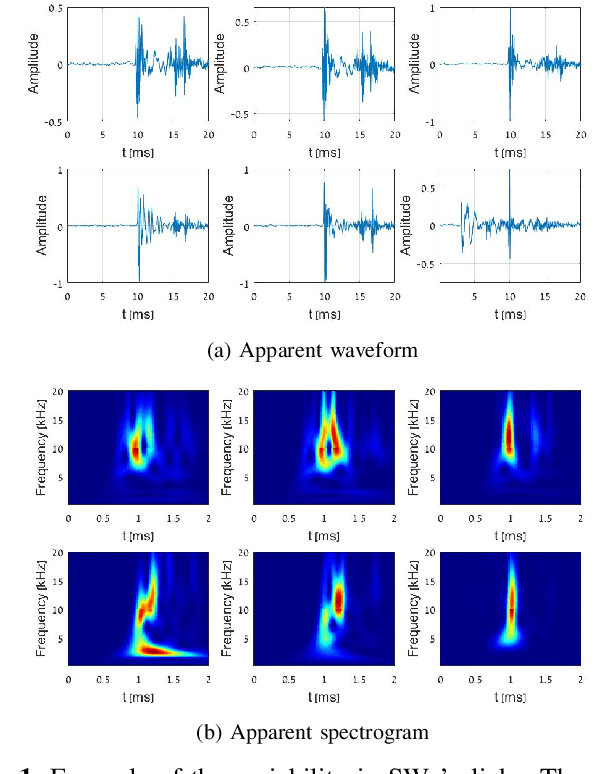
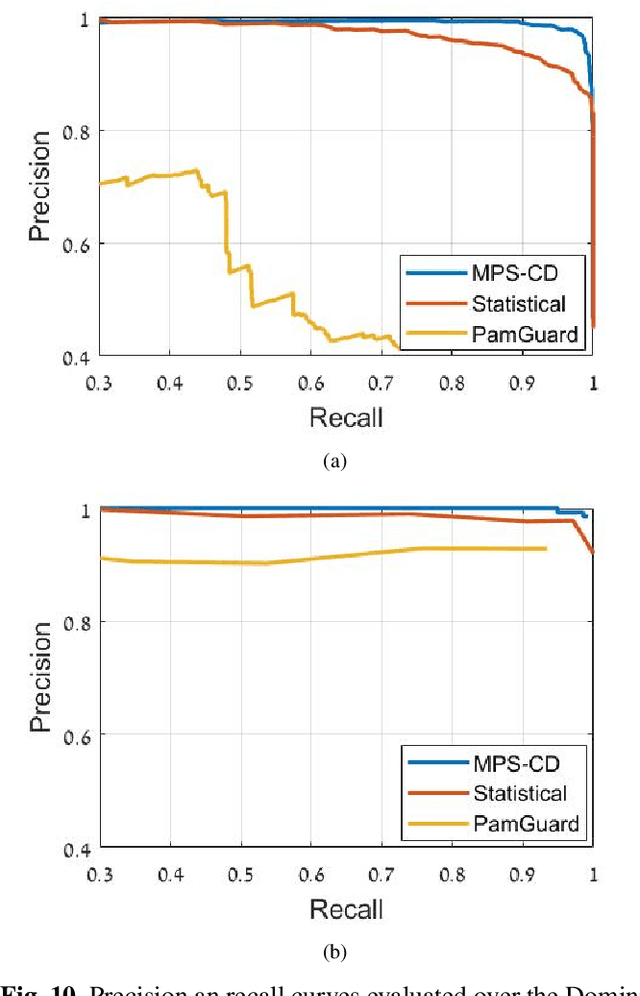
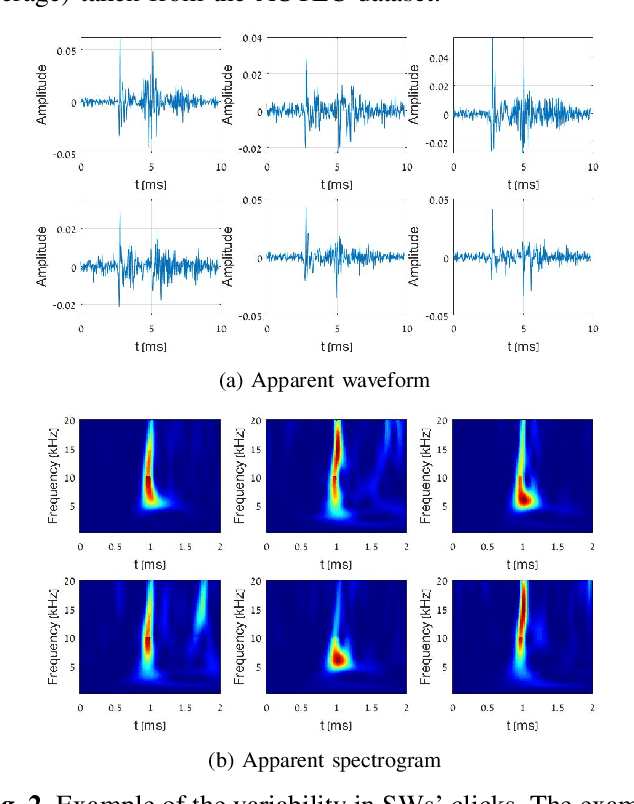
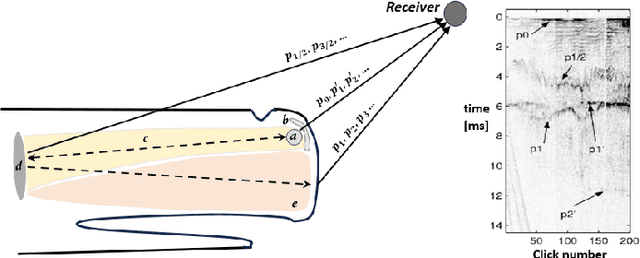
Abstract:Sperm whales (Physeter macrocephalus) navigate underwater with a series of impulsive, click-like sounds known as echolocation clicks. These clicks are characterized by a multipulse structure (MPS) that serves as a distinctive pattern. In this work, we use the stability of the MPS as a detection metric for recognizing and classifying the presence of clicks in noisy environments. To distinguish between noise transients and to handle simultaneous emissions from multiple sperm whales, our approach clusters a time series of MPS measures while removing potential clicks that do not fulfil the limits of inter-click interval, duration and spectrum. As a result, our approach can handle high noise transients and low signal-to-noise ratio. The performance of our detection approach is examined using three datasets: seven months of recordings from the Mediterranean Sea containing manually verified ambient noise; several days of manually labelled data collected from the Dominica Island containing approximately 40,000 clicks from multiple sperm whales; and a dataset from the Bahamas containing 1,203 labelled clicks from a single sperm whale. Comparing with the results of two benchmark detectors, a better trade-off between precision and recall is observed as well as a significant reduction in false detection rates, especially in noisy environments. To ensure reproducibility, we provide our database of labelled clicks along with our implementation code.
Underwater object classification combining SAS and transferred optical-to-SAS Imagery
Apr 24, 2023



Abstract:Combining synthetic aperture sonar (SAS) imagery with optical images for underwater object classification has the potential to overcome challenges such as water clarity, the stability of the optical image analysis platform, and strong reflections from the seabed for sonar-based classification. In this work, we propose this type of multi-modal combination to discriminate between man-made targets and objects such as rocks or litter. We offer a novel classification algorithm that overcomes the problem of intensity and object formation differences between the two modalities. To this end, we develop a novel set of geometrical shape descriptors that takes into account the geometrical relation between the objects shadow and highlight. Results from 7,052 pairs of SAS and optical images collected during several sea experiments show improved classification performance compared to the state-of-the-art for better discrimination between different types of underwater objects. For reproducibility, we share our database.
An Efficient Drifters Deployment Strategy to Evaluate Water Current Velocity Fields
Jan 10, 2023Abstract:Water current prediction is essential for understanding ecosystems, and to shed light on the role of the ocean in the global climate context. Solutions vary from physical modeling, and long-term observations, to short-term measurements. In this paper, we consider a common approach for water current prediction that uses Lagrangian floaters for water current prediction by interpolating the trajectory of the elements to reflect the velocity field. Here, an important aspect that has not been addressed before is where to initially deploy the drifting elements such that the acquired velocity field would efficiently represent the water current. To that end, we use a clustering approach that relies on a physical model of the velocity field. Our method segments the modeled map and determines the deployment locations as those that will lead the floaters to 'visit' the center of the different segments. This way, we validate that the area covered by the floaters will capture the in-homogeneously in the velocity field. Exploration over a dataset of velocity field maps that span over a year demonstrates the applicability of our approach, and shows a considerable improvement over the common approach of uniformly randomly choosing the initial deployment sites. Finally, our implementation code can be found in [1].
Automated Detection of Dolphin Whistles with Convolutional Networks and Transfer Learning
Nov 28, 2022Abstract:Effective conservation of maritime environments and wildlife management of endangered species require the implementation of efficient, accurate and scalable solutions for environmental monitoring. Ecoacoustics offers the advantages of non-invasive, long-duration sampling of environmental sounds and has the potential to become the reference tool for biodiversity surveying. However, the analysis and interpretation of acoustic data is a time-consuming process that often requires a great amount of human supervision. This issue might be tackled by exploiting modern techniques for automatic audio signal analysis, which have recently achieved impressive performance thanks to the advances in deep learning research. In this paper we show that convolutional neural networks can indeed significantly outperform traditional automatic methods in a challenging detection task: identification of dolphin whistles from underwater audio recordings. The proposed system can detect signals even in the presence of ambient noise, at the same time consistently reducing the likelihood of producing false positives and false negatives. Our results further support the adoption of artificial intelligence technology to improve the automatic monitoring of marine ecosystems.
Machine Learning-Based Distributed Authentication of UWAN Nodes with Limited Shared Information
Aug 19, 2022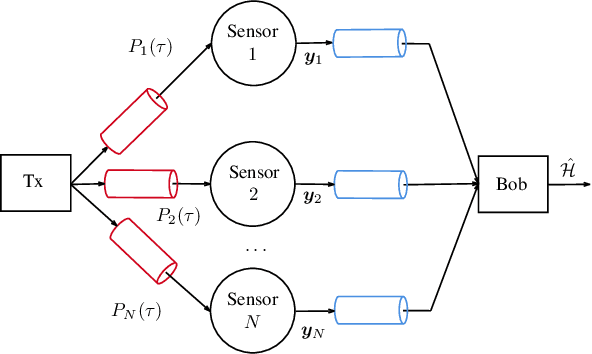
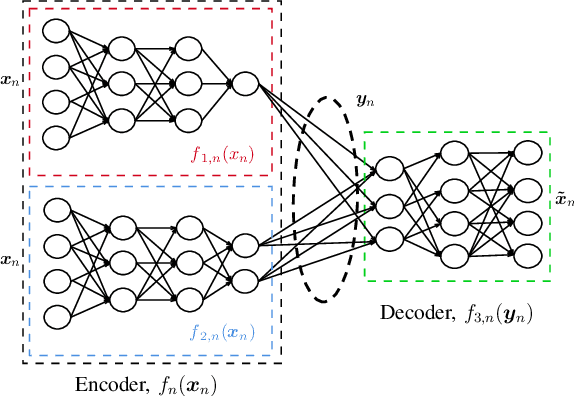
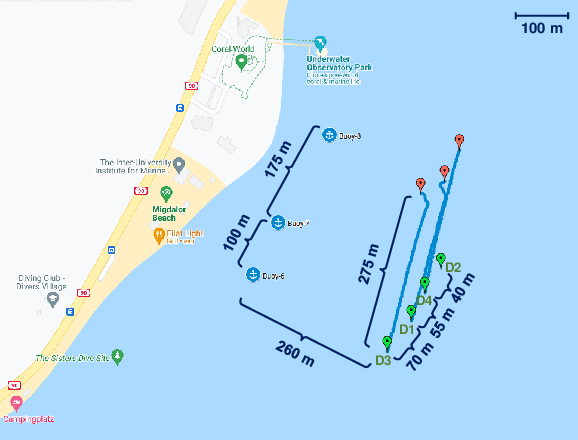
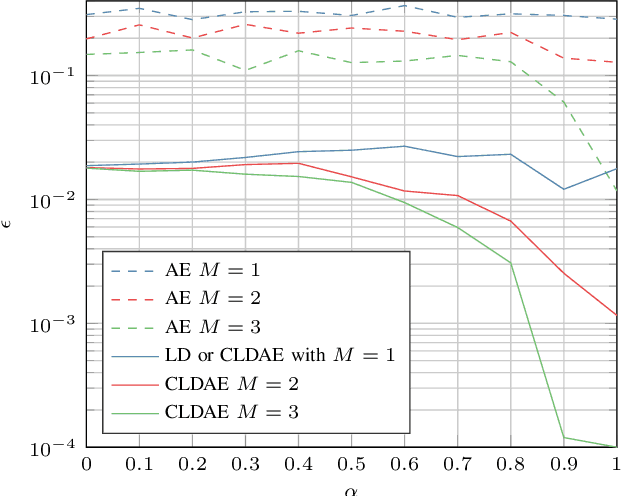
Abstract:We propose a technique to authenticate received packets in underwater acoustic networks based on the physical layer features of the underwater acoustic channel (UWAC). Several sensors a) locally estimate features (e.g., the number of taps or the delay spread) of the UWAC over which the packet is received, b) obtain a compressed feature representation through a neural network (NN), and c) transmit their representations to a central sink node that, using a NN, decides whether the packet has been transmitted by the legitimate node or by an impersonating attacker. Although the purpose of the system is to make a binary decision as to whether a packet is authentic or not, we show the importance of having a rich set of compressed features, while still taking into account transmission rate limits among the nodes. We consider both global training, where all NNs are trained together, and local training, where each NN is trained individually. For the latter scenario, several alternatives for the NN structure and loss function were used for training.
Sonar Point Cloud Processing to Identify Sea Turtles by Pattern Analysis
May 19, 2022



Abstract:Abundant in coastal areas, sea turtles are affected by high-intensity acoustic anthropogenic sounds. In this paper, we offer a pattern analysis-based detection approach to serve as a warning system for the existence of nearby sea turtles. We focus on the challenge of overcoming the low signal-to-clutter ratio (SCR) caused by reverberations. Assuming that, due to low SCR, target reflections within the point cloud are received in groups, our detector searches for patterns through clustering to identify possible 'blobs' in the point cloud of reflections, and to classify them as either clutter or a target. Our unsupervised clustering is based on geometrical and spectral constraints over the blob's member relations. In turn, the classification of identified blobs as either a target or clutter is based on features extracted from the reflection pattern. To this end, assuming reflections from a sea turtle are stable but include spectral diversity due to distortions within the turtles body, we quantify the stability of the blob's members and their spectral entropy. We test our detector in both modeled simulations, and at sea, for the detection of sea turtles released after rehabilitation. The results show robustness to highly-fluctuating target intensity and ability to detect at low SCR.
Design of an Optimal Testbed for Tracking of Tagged Marine Megafauna
Apr 08, 2022



Abstract:Underwater acoustic technologies are a key component for exploring the behavior of marine megafauna such as sea turtles, sharks, and seals. The animals are marked with acoustic devices (tags) that periodically emit signals encoding the device's ID along with sensor data such as depth, temperature, or the dominant acceleration axis - data that is collected by a network of deployed receivers. In this work, we aim to optimize the locations of receivers for best tracking of acoustically tagged marine megafauna. The outcomes of such tracking allows the evaluation of the animals' motion patterns, their hours of activity, and their social interactions. In particular, we focus on how to determine the receivers' deployment positions to maximize the coverage area in which the tagged animals can be tracked. For example, an overly-condensed deployment may not allow accurate tracking, whereas a sparse one, may lead to a small coverage area due to too few detections. We formalize the question of where to best deploy the receivers as a non-convex constraint optimization problem that takes into account the local environment and the specifications of the tags, and offer a sub-optimal, low-complexity solution that can be applied to large testbeds. Numerical investigation for three stimulated sea environments shows that our proposed method is able to increase the localization coverage area by 30%, and results from a test case experiment demonstrate similar performance in a real sea environment. We share the implementation of our work to help researchers set up their own acoustic observatory.
 Add to Chrome
Add to Chrome Add to Firefox
Add to Firefox Add to Edge
Add to Edge